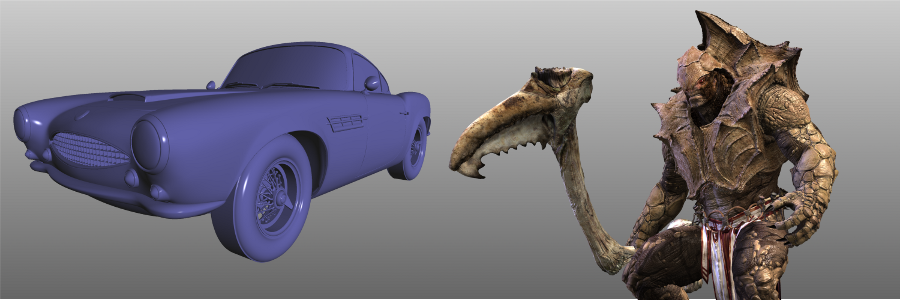Introduction

Introduction
OpenSubdiv is a set of open source libraries that implement high performance subdivision surface (subdiv) evaluation on massively parallel CPU and GPU architectures. This codepath is optimized for drawing deforming surfaces with static topology at interactive framerates. The resulting limit surfaces are a match for Pixar's Renderman specification within numerical precision limits.
OpenSubdiv is a code API which we hope to integrate into 3rd. party digital content creation tools. It is not an application, nor a tool that can be used directly to create digital assets.
Why Fast Subdivision ?
Subdivision surfaces are commonly used for final rendering of character shapes for a smooth and controllable limit surfaces. However, subdivision surfaces in interactive apps are typically drawn as their polygonal control hulls because of performance. The polygonal control hull is an approximation that is offset from the true limit surface. Looking at an approximation in the interactive app makes it difficult to see exact contact, like fingers touching a potion bottle or hands touching a cheek. It also makes it difficult to see poke-throughs in cloth simulation if the skin and cloth are both approximations. This problem is particularly bad when one character is much larger than another and unequal subdiv face sizes cause approximation errors to be magnified.
Maya and Pixar's proprietary Presto animation system can take 100ms to subdivide a character of 30,000 polygons to the second level of subdivision (500,000 polygons). Being able to perform the same operation in less than 3ms allows the user to interact with the smooth, accurate limit surface at all times.

Research
The new GPU technology behind OpenSubdiv is the result of a joint research effort between Pixar and Microsoft.
Feature Adaptive GPU Rendering of Catmull-Clark Subdivision SurfacesMatthias Niessner, Charles Loop, Mark Meyer, and Tony DeRoseACM Transactions on Graphics, Vol. 31 No. 1 Article 6 January 2012Efficient Evaluation of Semi-Smooth Creases in Catmull-Clark Subdivision SurfacesMatthias Niessner, Charles Loop, and Guenter Greiner.Eurographics Proceedings, Cagliari, 2012Analytic Displacement Mapping using Hardware TessellationMatthias Niessner, Charles LoopACM Transactions on Graphics, To appear 2013
Heritage
This is the fifth-generation subdiv library in use by Pixar's proprietary animation system in a lineage that started with code written by Tony DeRose and Tien Truong for Geriu2019s Game in 1996. Each generation has been a from-scratch rewrite that has built upon our experience using subdivision surfaces to make animated films. This code is live, so Pixar's changes to OpenSubdiv for current and future films will be released as open source at the same time they are rolled out to Pixar animation production.
Subdivision for Modeling and AnimationDenis Zorin, Peter SchroderCourse Notes of SIGGRAPH 1999Subdivision Surfaces in Character AnimationTony DeRose, Michael Kass, Tien TruongProceedings of SIGGRAPH 1998Recursively generated B-spline surfaces on arbitrary topological meshesCatmull, E.; Clark, J. Computer-Aided Design 10 (6) (1978)
Licensing
OpenSubdiv is covered by the Apache License, and is free to use for commercial or non-commercial use. This is the same code that Pixar uses internally for animated film production. Our intent is to encourage a geometry standard for subdivision surfaces, by providing consistent (i.e. yielding the same limit surface), high performance implementations on a variety of platforms.
Why Apache? We were looking for a commercial-friendly license that would convey our patents to the end users. This quickly narrowed the field to Microsoft Public License or Apache. Initially we chose MSPL because it handled trademarks better. But at the request of several companies we gave Apache another look, and decided to go with Apache with a very slight modification that simply says you cannot use any contributors' trademarks. In other words, you can use OpenSubdiv to make a product, but you cannot use a Luxo Lamp (or other character, etc.) when marketing your product.
Contributing
In order for us to accept code submissions (merge git pull-requests), contributors need to sign the Contributor License Agreement (CLA). There are two CLAs, one for individuals and one for corporations. As for the end-user license, both are based on Apache. They are found in the code repository (individual form, corporate form). Please email the signed CLA to opensubdiv-cla@pixar.com.
For more details about OpenSubdiv, see Pixar Graphics Technologies.
External Resources
- Microsoft Research:
- Charles Loop Matthias Niessner
- Pixar Research:
- Pixar R&D Portal
